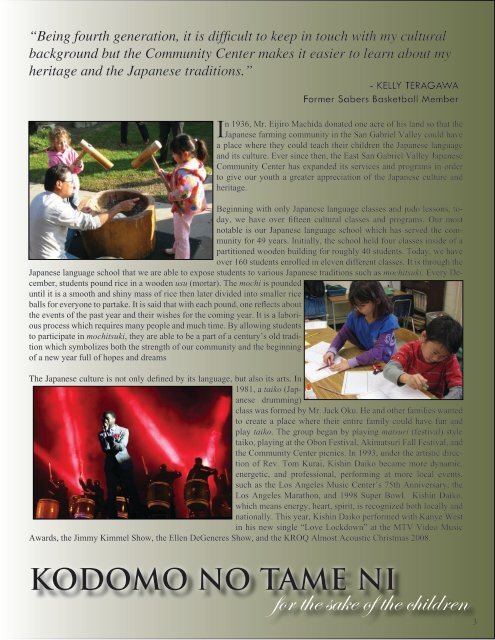east san gabriel valley japanese community center, inc.
east san gabriel valley japanese community center, inc.
east san gabriel valley japanese community center, inc.
You also want an ePaper? Increase the reach of your titles
YUMPU automatically turns print PDFs into web optimized ePapers that Google loves.
“Being fourth generation, it is difficult to keep in touch with my cultural<br />
background but the Community Center makes it easier to learn about my<br />
heritage and the Japanese traditions.”<br />
- KELLY TERAGAWA<br />
Former Sabers Basketball Member<br />
In 1936, Mr. Eijiro Machida donated one acre of his land so that the<br />
Japanese farming <strong>community</strong> in the San Gabriel Valley could have<br />
a place where they could teach their children the Japanese language<br />
and its culture. Ever s<strong>inc</strong>e then, the East San Gabriel Valley Japanese<br />
Community Center has expanded its services and programs in order<br />
to give our youth a greater appreciation of the Japanese culture and<br />
heritage.<br />
Beginning with only Japanese language classes and judo lessons, today,<br />
we have over fifteen cultural classes and programs. Our most<br />
notable is our Japanese language school which has served the <strong>community</strong><br />
for 49 years. Initially, the school held four classes inside of a<br />
partitioned wooden building for roughly 40 students. Today, we have<br />
over 160 students enrolled in eleven different classes. It is through the<br />
Japanese language school that we are able to expose students to various Japanese traditions such as mochitsuki. Every December,<br />
students pound rice in a wooden usu (mortar). The mochi is pounded<br />
until it is a smooth and shiny mass of rice then later divided into smaller rice<br />
balls for everyone to partake. It is said that with each pound, one reflects about<br />
the events of the past year and their wishes for the coming year. It is a laborious<br />
process which requires many people and much time. By allowing students<br />
to participate in mochitsuki, they are able to be a part of a century’s old tradition<br />
which symbolizes both the strength of our <strong>community</strong> and the beginning<br />
of a new year full of hopes and dreams<br />
The Japanese culture is not only defined by its language, but also its arts. In<br />
1981, a taiko (Japanese<br />
drumming)<br />
class was formed by Mr. Jack Oku. He and other families wanted<br />
to create a place where their entire family could have fun and<br />
play taiko. The group began by playing matsuri (festival) style<br />
taiko, playing at the Obon Festival, Akimatsuri Fall Festival, and<br />
the Community Center picnics. In 1993, under the artistic direction<br />
of Rev. Tom Kurai, Kishin Daiko became more dynamic,<br />
energetic, and professional, performing at more local events,<br />
such as the Los Angeles Music Center’s 75th Anniversary, the<br />
Los Angeles Marathon, and 1998 Super Bowl. Kishin Daiko,<br />
which means energy, heart, spirit, is recognized both locally and<br />
nationally. This year, Kishin Daiko performed with Kanye West<br />
in his new single “Love Lockdown” at the MTV Video Music<br />
Awards, the Jimmy Kimmel Show, the Ellen DeGeneres Show, and the KROQ Almost Acoustic Christmas 2008.<br />
KODOMO NO TAME NI<br />
for the sake of the children<br />
3


